|
FAQs about Non-Vertebrate Animal Identification
18
Related Articles: Marine Invertebrates, Quarantine of Corals and
Invertebrates, Feeding
Reef Invertebrates, Lighting
Marine Invertebrates, Water Flow, How Much
is Enough,
Related FAQs: Non-Vert IDs 1, Non-Vert IDs 2, Non-Vert IDs 3, Non-Vert IDs 4, Non-Vert IDs 5, Non-Vert IDs 6, Non-Vert IDs 7, Non-Vert IDs 8, Non-Vert IDs 9, Non-Vert IDs 10, Non-Vert IDs 11, Non-Vert IDs 12, Non-Vert IDs 13, Non-Vert IDs 14, Non-Vert IDs 15, Non-Vert IDs 16, Non-Vert IDs 17, Non-Vert. ID 19, Non-Vert. ID 20, Non-Vert. ID 21, Non-Vert. ID 22, Non-Vert. ID 23, Non-Vert. ID 24, Non-Vert. ID 25, Non-Vert ID 26, Non-Vert ID 27, Non-Vert ID 28, Non-Vert ID 29, Non-Vert ID 30 Non-Vert ID 31, Non-Vert ID 32, Non-Vert 33, Non-Vert ID 34, Non-Vert ID 35, Non-Vert ID 36, Non-Vert ID 37, Non-Vert ID 38, Non-Vert ID 39, Non-Vert ID 40, Non-Vert ID 41, Non-Vert ID 42, Non-Vert ID 43, Non-Vert ID 44, Non-Vert ID 45, Non-Vert ID 46, Non-Vert ID 47, Non-Vert ID 48, Non-Vert ID 49, Non-Vert ID 50, Non-Vert ID 51, Non-Vert ID 52, Non-Vert ID 53, Non-Vert ID 54, Non-Vert ID 55, Non-Vert ID 56,
Non-Vert ID
57, Non-Vert ID 58,
Non-Vert ID 59,
Non-Vert ID 60, Non-Vert ID 61,
& Marine Invertebrates, Marine Invert.s 2, Marine Invert.s 3, & FAQs about:
Marine Invertebrate Behavior,
Marine Invertebrate
Compatibility, Marine
Invertebrate Selection, Marine
Invertebrate Systems, Feeding
Reef Invertebrates, Marine
Invertebrate Disease, Marine
Invertebrate Reproduction, &
LR Life
Identification, LR Hitchhiker ID
1, Anemone Identification,
Aiptasia
Identification, Aiptasia ID 2,
Worm Identification, Tubeworm ID, Polychaete Identification, Snail Identification, Marine Crab
Identification, Marine Invert.s 1,
Marine Invert.s 2, Marine Plankton,
|
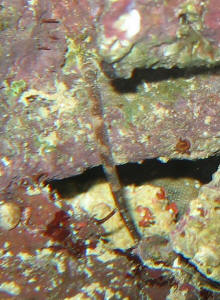
|
| A Species of Serpulid Worm -
11/22/06 Greetings WWM Crew and Happy Holidays! <<And to
you as well>> I have a small reef aquarium that has been set
up for 8 months. I have recently found 2 unknown
organisms and I am hoping you can help me clarify their identity.
<<I shall try>> Here is a picture of one of the
organisms, tubular shell structure attached to the LR, 2 antennae,
and it secrets a slime trail that seems to catch food particles.
<<Hmm, perhaps it is my aging eyes but I can't discern
much from this picture. But no worries, your description
is enough for me to say this is a species of Serpulid worm
(calcareous-tube building worms)>> It doesn't seem to
harm any of the corals or anemones. <<Indeed...I have/have
seen these many times...harmless if not beneficial>> I have
perused the internet to no avail. <<Try a keyword search on
the phrase 'Serpulid Worm'. Many species about,
but you may happen upon a description/photo of a specimen similar
to yours>> Thanks in advance! Mark A. Smith MAJ, AV United
States Army Reserve Command <<Quite welcome. Eric
Russell, MSgt, USAF (Retired)>> |
|
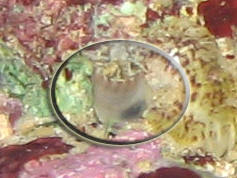
|
| Baby Sea Urchin vs. Limpet?
Hitchhiker ID Help Needed.... 11/20/06 Hi all- I
have looked over the website for the last few days trying to answer
my own question, but to no avail. I have also perused
Google Images (by the way, it's a great resource for those
trying to ID hitchhikers...type in the name of the animal and you
get many images). I found a creature stuck hard to the
wall of my aquarium and I didn't dare try to remove
it. The foot is oval shaped, cream colored, and about 2
cm long. Looking at it from the side it is about 1.5 cm
tall and kind-of slopes up. The center has a
hole in it. It looks like the pictures of limpets I have
seen, with one difference. In the center there are about
15-20 retractable darker brown spines/tentacles (only about 0.5 cm
long each). There is no apparent mouth/eyes/feelers that
I can see. I was thinking that it might be a baby sea
urchin until I touched it and found that the spines/tentacles and
body are all very soft and the spines/tentacles completely
retracted into the body of the animal. My attempt at
pictures are attached. Thanks for any help you may be
able to offer me. <Hello Melissa, Mich
here. Please don't be offended, but dammmm those
pictures are terrible! When I opened the file I
though I had forgotten to put my glasses back on. Does your camera
have a Marco setting? (It is often represented by a tiny
flower.) If you can find the macro setting on the
camera, you may get a better photo, which would be
helpful. Otherwise, my best guess from your written
description is it's a type of limpet of some sort. I
am also assuming the critter was found in a salt water
tank. Hope that helps. It's the best I
can do with the quality provided.> Melissa |
|
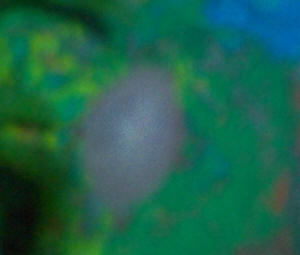
|
White windy things 11/18/06 WWM - I need
help. I am new to the salt water aquariums. I
have had my 75 gallon tank up for about 9 months now and I just noticed
a new addition to my aquarium. I thought it was a worm of
some sort and have searched your website but none of the pictures look
like my little visitor. It is a white long tube about 3
times as thick as a piece of hair and is very long and winds itself
up. I have 2 of these on the glass and one of these on a
rock. Can you let me know what it is and if it is
harmless?? <Mmm, is very likely harmless, but can't tell you
definitively which worm group (or even if this is a worm) for
certain> By the way you have a great site. I have learned
a ton over the last couple days trying to research this new
visitor. Any help would be appreciated. Kristin <I would
not be worried re these... will likely "pass" in time as
conditions, predation dynamic develops in your system. Bob
Fenner>
Mystery Critter: A Sea Pen...Maybe - 11/16/06
Hi Gang :) <<Hello Lisa>> I've been trying to
photograph this thing for ages but because it only comes out at
night and I can't get it with a red light, I get one shot with
a flash and the pics don't usually come out.
<<Bummer>> Tonight I got lucky. <<Cool>>
This thing http://www.webspecialty.com/aquarium/tankmysterything.jpg
is about 4 inches long. It is thick and doesn't look
like any other worm in the tank. It has spots. <<I
see them>> It reaches over and around rocks, I don't know
how long it actually can get, but when it recedes back into the
rock, you can't see any trace of it. <<Not
surprising/unusual>> From what I've been able to see of
it using the red light, the tip does not have anything on the end
of it. <<No head/mouth/feeding
apparatus? Hmm...maybe not a "worm">> Do
you know what it is? If so, would you please tell me?
<<Not sure myself, but Bob seems to think this could be a Sea
Pen...many species will only venture forth at
night. Have a look/read here (http://www.wetwebmedia.com/pennatulaceans.htm), and do
also a Google search on the Net in general re 'Sea
Pen'>> Thanks so much, Lisa
<<Happy to assist. EricR>> |
|

|
| Re: Mystery Critter: A Sea Pen...Maybe -
11/16/06 Thanks for the fast reply Eric. <<Quite
welcome>> I'd agree that it could be a Sea Pen, except it
isn't coming from soft substrate, it's coming from a rock.
<<Are you sure? You say you can't see it once
it retracts. Perhaps it is "originating" from
the substrate "under" the rock>> It reminds me of a
very long tentacle. <<Was my first impression as well>>
I'll keep searching. Lisa <<Please do let me know what
you discover. Eric Russell>> |
| R2: Mystery Critter - 11/16/06 Hi Eric,
<<Lisa>> Yup I'm positive. I've
watched it a lot. It comes out of the rock and then
spreads around the rock feeling all over it. If it
senses the light, it retracts back into the rock.
<<Curious>> When it starts to come back out, it starts
back out from its hole in the rock. The thicker end in
the picture is the base in the rock where it comes from
:) The other end of it is not visible in this pic.
<<Ahh, ok...I had visualized it as the
other-way-round. I still don't know what to tell
you, though I am back to leaning towards a species of worm
(thousands to contend with). The idea of a species of
eel has even entered my mind but you say the termination point has
no discernable "head." Have you considered
placing the rock in a tank of its own for closer
inspection/observation?>> Thanks, Lisa <<My interest is
piqued; I hope to hear what you discover of/more clues about this
organism. Regards, Eric Russell>> |
| R3: Mystery Critter - 11/16/06 Hi Eric,
<<Hey Lisa!>> We don't have another tank - yet -
but I'm sure this will certainly drive my husband and I to
purchase a Nano tank. <<Hee-hee!>> He really wants
seahorses. <<Wonderful creatures...but best kept in larger
systems for the increased water/system stability. If you
haven't found it already, do start reading here (http://www.wetwebmedia.com/tube-mfi.htm) and among the
associated linked files in blue at the top of the page>> The
problem with determining whether or not it's an eel is getting
close enough to it. <<So it seems>> At night I have to
use a red light to find it, but it senses that and retracts so I
only put the light on it long enough to locate it.
<<Mmm...very photosensitive indeed>> Then I get my
camera. I'll put a 4x close-up on and see if I can
get another picture of the thing with the other end in the picture.
<<Ah, good>> If I am able to get any other pictures or
find anything else, I'll be sure to let you know.
<<Please do>> Best, Lisa <<Regards, Eric
Russell>> |
Help With Lisa' Mystery Critter - 11/18/06
Hello, <<Howdy>> I read your FAQ's almost every day and
I noticed the email conversations regarding the email I included at the
bottom of this message. <<Ok>> Not to butt in <<No
worries>> but it seemed like you were kind of stumped and I
thought maybe I could try to help you out since you have helped me so
much in the past! <<Help is always welcome>> I saw the
photo yesterday that Lisa had submitted and I am almost 99% sure that
the creature in her picture is some kind of worm. <<Very likely,
yes>> I have numerous worms in my tank that look exactly like the
one in her photo. <<Really?>> They are black (dark gray)
and white, only come out at night, and are extremely sensitive to
light. <<Does sound very similar>> I have had them in my
tank for over a year now and have only recently noticed (within the
last month) that if you pay close attention to them, the very end of
their Head (?) is similar in appearance to a feather duster but not
feathery, more like 5 or 6 short tentacles (don't know if this
makes sense but it is the only way of explaining it without drawing a
picture). <<Does make sense...very interesting>> When the
worm retreats, the tentacles retract into the body and the worm shrinks
away. Obviously I spend way too many hours gawking at my
fish tank, even after the lights go out! <<Hee! Much
to be seen even when the lights are out...>> Unfortunately I have
no idea what the name of this creature is, only that I am quite sure it
is some kind of worm. <<Does sound as if...>> Also, it has
never seemed to bother anything in my tank, only beneficially
scavenging around the rocks. <<As is the case with most>> I
hope this is helpful. I am certainly not an expert; so if my
input is in any way annoying, please let me know. I
won't be offended and will refrain from making any suggestions in
the future. <<I am no expert either...and I "thank you"
for this input>> On the topic of worms, two quick questions while
I'm writing, if you don't mind? <<Not at all>> I am
thinking about getting a tank raised Pseudochromis fridmani and have
read that these fish eat worms. <<Very often true>> I enjoy
the diversity of the many different worms in my 55gal. Do
you think this fish would decimate my population of worms or just keep
them in check? <<Mmm, hard to say...but likely the latter>>
Also, are these guys prone to jumping out? <<Have heard
so>> I know that any fish can, but I am curious if these fish are
very likely to do this. <<These fish are widely considered to be
as "jumpy" as many of the commonly kept wrasse
species>> I want to leave my tank uncovered. <<I
would...>> Thanks so much for all your help!!! -Nick
<<Quite welcome. EricR>>
Re: Nitrates, Now ID Question 11/15/06 Hi James,
<Hello Jon> I have some creatures/ things that I need help in
identifying. I am beginning to think that a good digital camera is a
must part of reef keeping. All I have right now is my old 35 mm film
based camera. I tried taking pictures but without the zooming
capability, <Macro capabilities are much better in this
regard. Most digital cameras have this feature.> I will
probably just end up with arrows on the pictures and say 'look
James can you see it?' So I guess I will just have to describe it
as best I can for now. I have a lot (guesstimate probably 100+) of this
tiny white spiral shell like things appearing on my tank glass and live
rocks. They are about 1 mm in size (circumference). I tried researching
for a description/name and/or pictures at your website and other
websites using keywords as described above and came across the word
'spirorbidea'. But I am still not sure what to make of it
without photos to compare it to. So I have decided to ask you again. I
feel guilty for not knowing this upfront and end up bothering you all
the time. <No problem, I am continually learning about creatures as
you will be.> Please accept my apology in advance and at the same
time express my utmost appreciation for your generosity in lending us
your wealth of knowledge and experience, your valuable inputs for all
of us new hopefuls. <Thank you for the kind words. The
wealth of knowledge is spread amongst the crew, some being more
knowledgeable on some subjects than others.> Going back, what do you
think they are? <Without a pic, I'd say they are Spirorbid
Tubeworms (polychaeta).> Are these spiral shell-like things the
initial stages on the life of an Aiptasia? <Nope.> I just hope
that this is not the dreaded Aiptasia everyone is talking about.
<Not to worry.> How can I differentiate it between a fan worms if
they are still small. I am now confused if what I have in my tank are
fan worms, Aiptasia, or this spirorbidea. <Use a magnifying glass to
observe, should see the very small fan of the worm.> Also, there are
a few cocoon-like things with hairs on the tip that are mostly growing
on the low light portions of my live rocks. One of the cocoons is
almost 3 cm long. I can best describe it as a wad of cotton. <Again,
without a pic...? I've seen such, Bob would know, Oh
Bob...> <<Likely sponges, perhaps other sedentariate
Polychaetes... RMF>> In addition, I have these small shrimp like
bugs that is probably less than 5 mm long. I have a lot of them. I mean
a lot. They are all over the place moving in and out of the live rocks
and even on the sand. Even my refugium has them. If my guess is right,
I think it is called an amphipod. <Amphipods/Copepods, and as you
say, beneficial.> I have seen photos of it online and it sure look
like it. They are beneficial and are detritivores right? Do some if not
all types of fish eat them? <Yes to both, but smaller fish will dine
on them more so than larger fish.> I ask because my fish seems to
ignore them. These critters travel all over my tank boldly. There
hasn't been a day that I have not seen their empty shell floating
around. Maybe my fish simply like the formula 1 and 2 flakes soaked in
garlic a lot better. Every time I approach the tank, all my fishes are
like dogs wiggling tail asking for more food. My clowns and green
chromis eat right off my hand. They are so used to my hand in the tank
now they are no longer afraid of it. <Ahh, the beginner's joys
of discovery.> What can you say about aqua cultured fighting conch?
<Good herbivores, although they grown quite large. As
they grow, there will generally not be enough food on the rocks to
satisfy them, and supplemental feedings of dried seaweed will be
necessary for their survival. My opinion, not worth the
effort.> For the last fish in my tank, I will be adding a copperband
butterfly fish simply for its looks. I just love its profile and
coloration. <Everyone does.> I know it is a difficult fish to
keep but knowing myself, I would still end up getting it anyways as I
have already set my mind on it even before I started the tank. What
would be your advice to me for me to successfully keep it? I have not
lost a single livestock yet and I intend to keep it that way.
<Copperbands do best in large tanks with plenty of healthy live
rock. Any tubeworm population will soon be
gone. Your copepod population will quickly diminish
also. The difficulty with these fish is acclimating them to
prepared/frozen foods. Read FAQ's here re this.
http://www.wetwebmedia.com/chelmonfdgfaq.htm> Bioload: 2
false percs, 3 green chromis, 1 purple firefish, 10 Cerith snails, 10
margarita snails, 10 turbo snails, 20 blue legged hermit crabs, 1
serpent star, 1 peppermint shrimp, and 1 cleaner shrimp, 1 Frogspawn, 1
Hammer Coral, 1 Yellow Fiji Leather Coral, Multi-Colored Polyp colony
and 1 green open brain. <Yikes! Would not put a
Copperband in a tank with these corals. There will more than
likely be nipped on.> Tank: 60 gallon tank (48' x 25' x
12') with 28.45 gal DIY sump/ refugium. Equipment: 260 watt total
(12k and True Actinic 03 combination), 125 Coralife Needle Wheel Super
Skimmer, 18 watt 6x Coralife Twist UV Sterilizer, 2 200 watt Jager
Heater, Mag 5 return pump, and 2 Maxijet 1200 powerhead. Thanks again
James and more power to you and your site. <You're welcome,
Jon. James (Salty Dog)> Jon Glorioso Naugatuck, CT
<Luck you, living in such a scenic area.>
| "Creeping Killer Crud"
12/16/06 First of all, I really appreciate your forum. I've
been a chemist for 25+ years but find the reef keeping hobby to be
a quite a challenge! <Heeee! Agreed> It's been made more
enjoyable by your very helpful information. <Ah, good... as an
aside, I taught H.S. Chemistry for a while...> I have: 50 gallon
bow front aquarium 2 PFO pendants, each with 175W 10K halide and 2X
32W actinics 20 gallon sump Euroreef skimmer about 65 lbs. live
rock yellow tang maroon clown watchman goby mushroom corals bubble
tip anemone (2 now) small Acropora various polyps, mostly from live
rock emerald crab 'pom pom' crab Cleaner shrimp Nassarius,
bumble bee snails Blue & red legged hermits (8-10) Tank is
about 4 years old, maintain chemistry mainly with Kalkwasser in
replacement water & 2 part calcium and/or buffer when needed.
Have had many lapses with water changes (I'm guilty!) but try
to keep up with regular testing for pH, alkalinity, calcium,
nitrate, etc. testing. Parameters are all good, with some
detectable phosphate (~0.1ppm) leading me to run some phosphate
scrubbing resin right now as I try to starve this killer crud
encrusting my tank! <Mmmm> About 6 months ago, I began
noticing some dark, brownish (purplish?) growth on live rock that
seemed to spread fairly quickly (see attachment). <I see it>
Figured it was just some nuisance algae <Mmm, no> and
replenished some crabs to take care of it. However, it has grown
steadily and seems to slowly kill most things in it's path
(Acropora, open brain coral, pulsing Xeniids), only star polyps,
Palythoas and some other polyps seem to survive. The stuff looks
shiny and feels rubbery to the touch, but when you try to scrape it
off it is fibrous, almost leathery and very tough. <Yes...
likely a sponge, Poriferan> I've taken it to a very good LFS
and marine biologist there is stumped so far. This stuff grows from
rock to rock, even grows on top of coralline on back of tank where
I can eventually break it loose, but it has glued most of my live
rock together! LFS suggests removing & scrubbing
live rock, but won't this kill what's left of natural
flora/fauna? I'm considering replacing the appx. ½
of my live rock but would like to know what I'm up against
first. Any suggestions? Many thanks, Allen <Well... there are a
few approaches one might consider here... I'll jump ahead at
both ends/philosophies if you do/don't mind... If this were
a/my service account, I'd pull all the rock (as in en toto) out
and place it in the dark somewhere... allow/kill off the
"crud"... and use the old rock some months hence as
"base" in another set-up... At the opposite end of the
spectrum, IF this were my home tank and I was given to
experimentation, had lots of patience... I'd take a look/see
under a scope to determine at least the phylum here... and try a
course of possible, probable predators... Might take a bit of
time... to seek out an expert at family, genus, species of the
organism itself... someone who could engage you in what they have
observed and/or speculate might be a principal predator... AND I
would try the biochemical warfare route... adding another
purposeful sump/refugium, macrophyte... lighting... tied in with
your main system here... Much to be gained, enjoyed in considering,
pursuing these activities. Bob Fenner> |
|
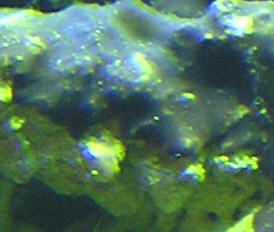
|
Help! Small reef, critters 12/4/06
Hey! <Get me my saddle!> I've been successfully looking after
my black & white clown in a 30 ltr aquarium for a few months now.
<Too small a volume...> He is in there with a few
other critters too. The setup is as follows: I have a
Mirabello 30 aquarium: I have replaced the carbon with a VERY good
phosphate remover laid out in wool. It has plenty of
biological action on the go and I use nothing but synthetic seawater
for water changes. There is a venturi device that is turned
down very low (it causes a very small timed jet of bubbles) and an
Interpet AirVolution Mini. I use test kits and never have readings of
nitrites, nitrates or phosphates. I have replaced the standard yellow
lights with a blue/white actinic light bulb. Everything mechanically
and filter wise is good. My inhabitants are: 1 x 1" black &
white clownfish 1 x 3/4" emerald crab 1 x 1" blue-legged
hermit crab 1 x 1" turbo snail 1 x 1" red snail (I picked up
from the Irish Sea on holiday and brought him back - doing great) Lots
of live rock, an anemone (the clown never leaves it!), polyps, xenia.
<... dangerous mix in time> Plenty of Mysid shrimp, baby snails,
worms and weird things that grow on the glass. Here lies my
problem. What are the things on the glass? I have
done lots of research and found that people often complain about pods -
white things that sit on the glass. My pest is brown and 1 -
2 mm in size. They have a lighter part in the middle of
their body. Any ideas? <All sorts> What can I do to
get rid of them - especially in the way of fish. I hope you
will say that a neon goby will eat them up. <Maybe... but I'm
inclined to leave these be... whatever they are... highly likely
innocuous to beneficial... will pass in time...> Also, I have found
a baby starfish - I'm pretty sure it's a
brittle-star. It is nearly all white except for it's
main body part - is this normal for babies (It's body is no more
than 2mm in diameter)? <See WWM re http://www.wetwebmedia.com/asterinafaqs.htm>
Well, thanks for listening, I know I've dribbled on but I am please
that my first venture into marine aquaria is doing well. Si <Thank
you for sharing. Re my concerns about the species listed... please do
look these up individually on WWM, read re their Compatibility,
Systems... Bob Fenner>
| Unidentified Egg Sacks -
12/01/06 Hello, my name is Michael. <<Hi Michael...Eric
here...>> First off, thank you for being such a helpful site.
<<Glad you think so>> Your site has stopped me from
making countless mistakes and has helped me diagnose and save the
life of one of my sick clownfish =). <<Excellent to
hear!>> Anyways, today I noticed about twelve small white egg
sacks the size of pin heads on my tank glass. They are
almost evenly dispersed near the top of three of the
walls. I sent a drawing I made of them close up.
<<I see it>> I know it is not very clear and could
easily be from many types of creatures but I only have two types of
creatures in my tank that I think could possibly make
them. I have a somewhat new pair of True Percula
Clownfish that seem to have paired nicely but I am not sure if
clownfish would produce 12 small egg sacks and then put them
everywhere while leaving them unguarded even if it would be their
first time having babies. <<Mmm, no...these are definitely
not clownfish eggs>> I also have some turbo snails in the
tank but I think that their egg pattern looks different.
<<Indeed...long ragged-looking white strings>> I then
have crabs, a few corals, and some other species of fish but none
are in mated pairs. <<Pairing is not always/many times
unnecessary for an organism to produce "eggs">> So
if it is possible, could you venture a guess as what type of eggs
these are? <<Sure...if the "membrane" were more
round/symmetrical I would say these were egg-clusters from a
species of Nassarius snail. I think it likely these are
from "some" type of mollusk (probably a hitchhiker on
coral/live rock), and very likely harmless if not
beneficial>> Could they have come from something besides the
clowns or snails? <<As just stated>> Thanks very much
for your time and any help you can give me, <<A pleasure to
assist. EricR>> |
|

|
| Unknown
ID 11/24/06 Attached is a picture of something
growing in my salt tank. It is clear and seems to have an opening
in the end. Some of them have a small feather in the middle that
seems to be feeding. Please let me know what you think it might be
and if it is dangerous to my fish and Invertebrate.
<Hello! Mich here. I'm not sure what
you're specifically referring to in your
photo. I'm guessing the rounded mass in the crevasse
of the coral skeleton toward the bottom right. Hopefully
we are both looking at the same thing! This mass
resembles a sponge. However most sponges don't have
"feathers". Your written description makes me
think you may be describing barnacles or polychaete
worms. In any case, your fish and inverts should be
safe.> Cindy Shanks |
|
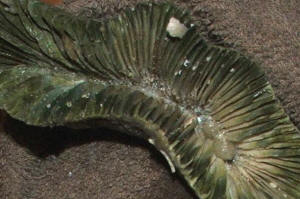
|
|
|

